Mechanical Characteristics Testing and Parameter Optimization of Rapeseed Blanket Seedling Conveying for Transplanters
Abstract
:1. Introduction
2. Materials and Methods
2.1. Structure and Working Principle
2.2. Compression Analysis of Rapeseed Seedling Blanket
2.2.1. Compression Force Analysis of Seedling Blanket
2.2.2. Compression Performance Analysis of Seedling Blanket
2.2.3. Mechanical Compression Test on Seedling Blanket
2.2.4. Compression Equation and Single-Factor Test
2.3. Parameter Optimization Test
2.3.1. Test Conditions
2.3.2. Test Method
- Compression amount
- Coefficient of variation in seedling conveying distance
- Qualified-block-cutting rate
3. Results
3.1. Test Results and Analysis
3.2. Field Verification Test
4. Discussion
5. Conclusions
Author Contributions
Funding
Institutional Review Board Statement
Data Availability Statement
Acknowledgments
Conflicts of Interest
References
- Wang, Z.Y.; Leng, S.H.; Zhang, Y.; Zhou, X.Y.; Gong, C.H.; Zuo, Q.S.; Yang, G. Research Progress on Seedling Transplanting Technology of Rapeseed Blanket-like Seedlings. Jiangsu J. Agric. Sci. 2023, 39, 1247–1255. [Google Scholar]
- Liu, X.H.; Feng, Q.N.; Leng, S.H.; Zuo, Q.S.; Yang, G.; Lu, J.Y.; Lu, Y.Z. Suitable Concentration of Matricom IZ for Improving Substrate of Rapeseed Blanket Seedling. Chin. J. Oil Crop Sci. 2020, 42, 188–193. [Google Scholar]
- Liu, X.H. Effects of Base Fertilizer Rate and Density on the Quality of Rapeseed Blanket Seedlings. Ph.D. Thesis, Yangzhou University, Yangzhou, China, 2021. [Google Scholar]
- Zhou, M.; Sun, H.; Xu, X.; Yang, J.; Wang, G.; Wei, Z.; Xu, T.; Yin, J. Study on the Method and Mechanism of Seedling Picking for Pepper (Capsicum annuum L.) Plug Seedlings. Agriculture 2024, 14, 11. [Google Scholar] [CrossRef]
- Markumningsih, S.; Hwang, S.-J.; Kim, J.-H.; Jang, M.-K.; Nam, J.-S. Stress Simulation on Four-Bar Link-Type Transplanting Device of Semiautomatic Vegetable Transplanter. Agriculture 2024, 14, 42. [Google Scholar] [CrossRef]
- Wu, J.; Yu, W.Y.; Zhang, M.; Wu, C.Y.; Jiang, L.; Tang, Q. Design and Experiment of 2ZY-6 Rapeseed Blanket Seedling Transplanter. Trans. Chin. Soc. Agric. Mach. 2020, 51, 95–102, 275. [Google Scholar]
- Tang, Q. Key Technologies Research of Combined Transplanter for Rapeseed Blanket Seedlings. Ph.D. Thesis, Chinese Academy of Agricultural Sciences, Beijing, China, 2022. [Google Scholar]
- Jiang, D.; Guan, Z.H.; Jiang, L.; Wu, J.; Tang, Q.; Wu, C.Y.; Cai, Y.J. Experimental Study on the Soil Conditions for Rapeseed Transplanting for Blanket Seedling Combined Transplanter. Agriculture 2024, 14, 310. [Google Scholar] [CrossRef]
- Feng, S.J.; Wu, M.L.; Yan, B.; Quan, W. Design and Test of Eject Lifting Type Pot Seedling Detaching Device. Trans. Chin. Soc. Agric. Eng. 2020, 36, 50–58. [Google Scholar]
- Jin, X.; Li, D.; Ma, H. Development of Single Row Automatic Transplanting Device for Potted Vegetable Seedlings. Int. J. Agric. Biol. Eng. 2018, 11, 67–75. [Google Scholar] [CrossRef]
- Zhao, M. Design and Experimental Research of Mechanism for Picking Up and Delivering Seedling in Tomato Plug Seedling Transplanter. Ph.D. Thesis, Shihezi University, Shihezi, China, 2023. [Google Scholar]
- Ma, R.J.; Ou, Y.G.; Zhao, Z.X.; Li, Z.W. Development of the Order Throwing Maching for Rice Seedlings Sprouted in the Cell-tray. Trans. Chin. Soc. Agric. Eng. 2003, 19, 113–116. [Google Scholar]
- Tsuga, K. Development of Fully Automatic Vegetable Transplanter. Jpn. Agric. Res. Q. 2000, 34, 21–28. [Google Scholar]
- Kumar, G.V.; Raheman, H. Automatic Feeding Mechanism of a Vegetable Transplanter. Int. J. Agric. Biol. Eng. 2012, 5, 20–27. [Google Scholar]
- Ye, B.L.; Zeng, G.J.; Deng, B.; Yang, C.L.; Liu, J.K.; Yu, G.H. Design and Tests of a Rotary Plug Seedling Pick-up Mechanism for Vegetable Automatic Transplanter. Int. J. Agric. Biol. Eng. 2020, 13, 70–78. [Google Scholar] [CrossRef]
- Yu, G.H.; Wang, L.; Sun, L.; Zhao, X.; Ye, B.L. Advancement of Mechanized Transplanting Technology and Equipments for Field Crops. Trans. Chin. Soc. Agric. Mach. 2022, 53, 1–20. [Google Scholar]
- Zhao, Y.; Huang, J.B.; Zhang, W.W. Design of Wear-resitance Seeding Feeder Mechanism of Rotary Rice Transplanter. Trans. Chin. Soc. Agric. Mach. 2011, 42, 58–62. [Google Scholar]
- Du, L.H.; Yu, G.H.; Zhang, G.F.; Li, G.; Liu, D.Q. Design and Experiment of Vertically Feeding-seedling Device for Pot-blanket Seedling Based on High-speed Rice Transplanter. Trans. Chin. Soc. Agric. Eng. 2014, 30, 17–25. [Google Scholar]
- Guo, H.; Chen, Z.; Jia, H.L.; Zheng, T.Z.; Wang, G.; Wang, Q. Design and Experiment of Soil-covering and Soil-compacting Device with Cone-shaped Structure of Wheel. Trans. Chin. Soc. Agric. Eng. 2017, 33, 56–65. [Google Scholar]
- Li, G.X.; Zhang, B.Y.; Yu, Y.Z. Soil Mechanics, 3rd ed.; Tsinghua University Press: Beijing, China, 2022; pp. 6–27, 127–139. [Google Scholar]
- Huo, L.F. Study on Compaction Mechanism of Paddy Soil Based on Soil Compression and Fragmentation Methods. Ph.D. Thesis, Nanjing Agricultural University, Nanjing, China, 2020. [Google Scholar]
- Wang, Y.; Chen, J.N.; Wu, J.W.; Zhao, Y. Mechanics Property Experiment of Broccoli Seedling Oriented to Mechanized Planting. Trans. Chin. Soc. Agric. Eng. 2014, 30, 1–10. [Google Scholar]
- Miao, X.H.; Mao, H.P.; Han, L.H.; Sun, H.; Yang, X.J.; Huang, H. Analysis of Influencing Factors on Force of Picking Plug Seedlings and Pressure Resistance of Plug Seedlings. Trans. Chin. Soc. Agric. Mach. 2013, 44 (Suppl. S1), 27–32. [Google Scholar]
- Song, Q.; Yu, J.Z.; Wang, W.B.; Feng, J.A. Analysis and Optimization of Mechanical Properties of Tomato Plug Seedling Bowls. J. Univ. Jinan (Nat. Sci. Ed.) 2019, 33, 529–536. [Google Scholar]
- Yu, G.H.; Du, L.H.; Li, G.; Xu, Y.P.; Ye, B.L.; Liu, D.Q. Design and Experiment of Seedling Conveying Device for High-Speed Rice Bowl Seedling Transplanter. Trans. Chin. Soc. Agric. Mach. 2015, 46, 39–45. [Google Scholar]
- Zhang, X.A. Agricultural Machinery Design Manual, 1st ed.; China Agricultural Science and Technology Press: Beijing, China, 2007; p. 469. [Google Scholar]
- Gu, F.W.; Zhao, Y.Q.; Hu, Z.C.; Shi, L.L.; Wu, F.; Xu, H.B.; Gao, X.M. Operation analysis and parameter optimization of conveying device for uniform crushed straw throwing and seed-sowing machines. Int. J. Agric. Biol. Eng. 2023, 16, 28–36. [Google Scholar] [CrossRef]
- Fan, J.; Li, Y.; Luo, W.; Yang, K.; Yu, Z.; Wang, S.; Hu, Z.; Wang, B.; Gu, F.; Wu, F. An Experimental Study of Stem Transported-Posture Adjustment Mechanism in Potato Harvesting. Agronomy 2023, 13, 234. [Google Scholar] [CrossRef]
- Mou, X.; Wan, F.; Wu, J.; Luo, Q.; Xin, S.; Ma, G.; Zhou, X.; Huang, X.; Peng, L. Simulation Analysis and Multiobjective Optimization of Pulverization Process of Seed-Used Watermelon Peel Pulverizer Based on EDEM. Agriculture 2024, 14, 308. [Google Scholar] [CrossRef]
- He, Y.H.; Jin, P.W. Orbit Error Correction Algorithm Based on Wavelet Robust Least Square Estimation and Its Application in DEM. J. Geod. Geodyn. 2020, 40, 1273–1276, 1289. [Google Scholar]
- Jiang, L.; Tang, Q.; Zhang, M.; Wu, C.Y.; Wang, G.; Wu, J.; Guan, Z.H. Improvement Design and Experimental Study of Seedling Pick-up Paraments of Planting System for Rape Blanket Seedling Transplanter. IAEJ 2021, 30, 118–127. [Google Scholar]
- Yi, S.J.; Zhang, G.; Li, Y.F.; Li, B.H.; Luo, L.S.; Wang, P. Design and Experiment of a Fully Automatic Plate Lifting Machine for Rice Ha Disk Seedling Cultivation. Agriculture 2023, 13, 1929. [Google Scholar] [CrossRef]
- Yue, R.; Hu, J.; Liu, Y.; Yao, M.; Zhang, T.; Shi, J. Design and Working Parameter Optimization of Pneumatic Reciprocating Seedling-Picking Device of Automatic Transplanter. Agriculture 2022, 12, 1989. [Google Scholar] [CrossRef]
- Han, C.J.; Xu, Y.; Zhang, J.; You, J.; Guo, H. Design and experiment of semi-automatic transplanter for watermelon seedlings raised on compression substrate. Trans. Chin. Soc. Agric. Eng. (Trans. CSAE) 2018, 34, 54–61. [Google Scholar]
- Zhang, N.; Zhang, G.Z.; Fu, J.W.; Liu, W.R.; Chen, L.M.; Tang, N.R. Design and experiment of the seedling pick-up device with ejecting potclamping stem combination. Trans. Chin. Soc. Agr. Eng. (Trans. CSAE) 2024, 40, 50–61. [Google Scholar]
- Wang, L.J.; Hao, Y.P.; Liu, K.S.; Yang, X.Z.; Sun, G.X.; Yu, J. Optimization of Water Extraction Technology of Chaihu Anxin Capsules by Box-Behnken Response Surface Method Combined with Multi-index Comprehensive Scoring Method. China Pharm. 2019, 30, 632–637. [Google Scholar]

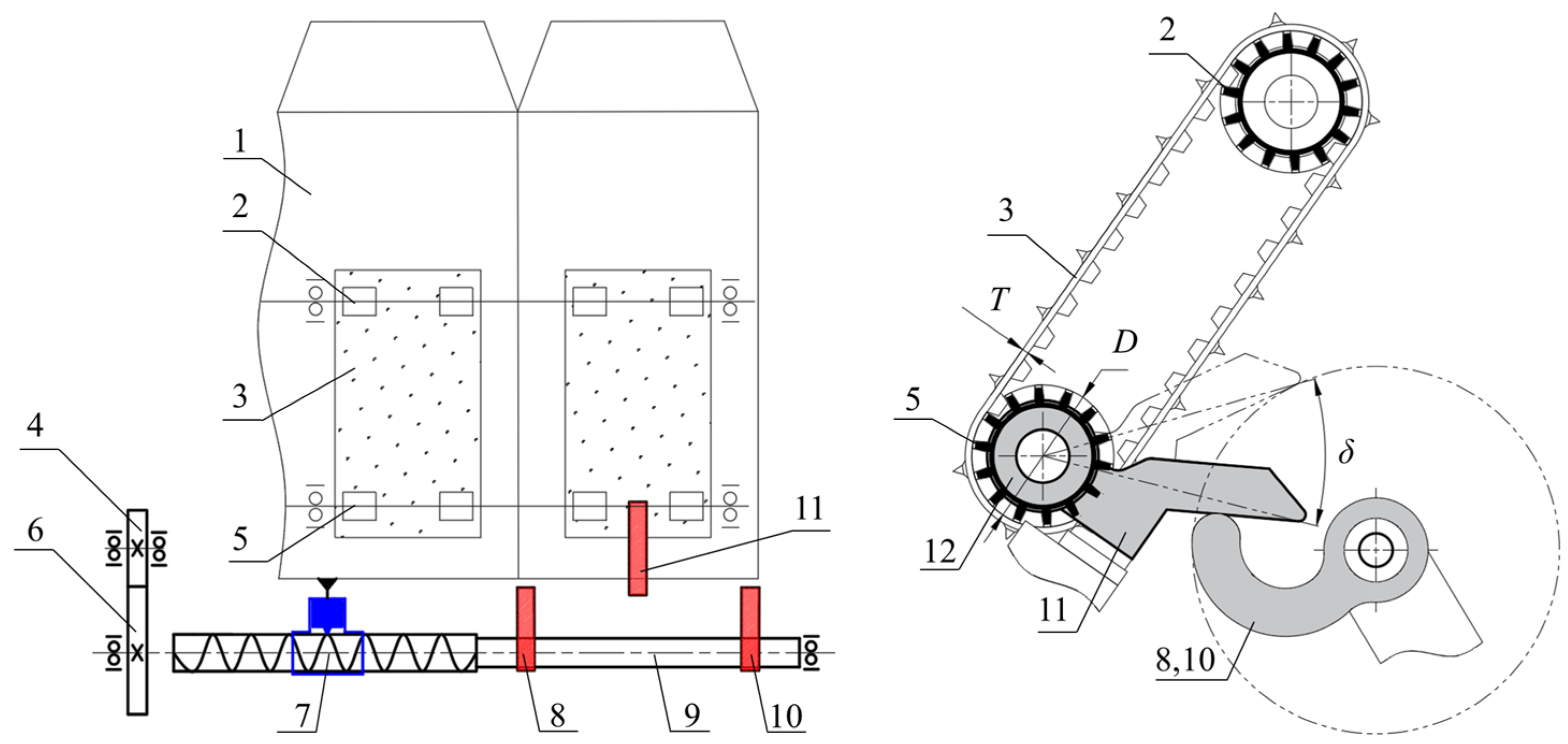
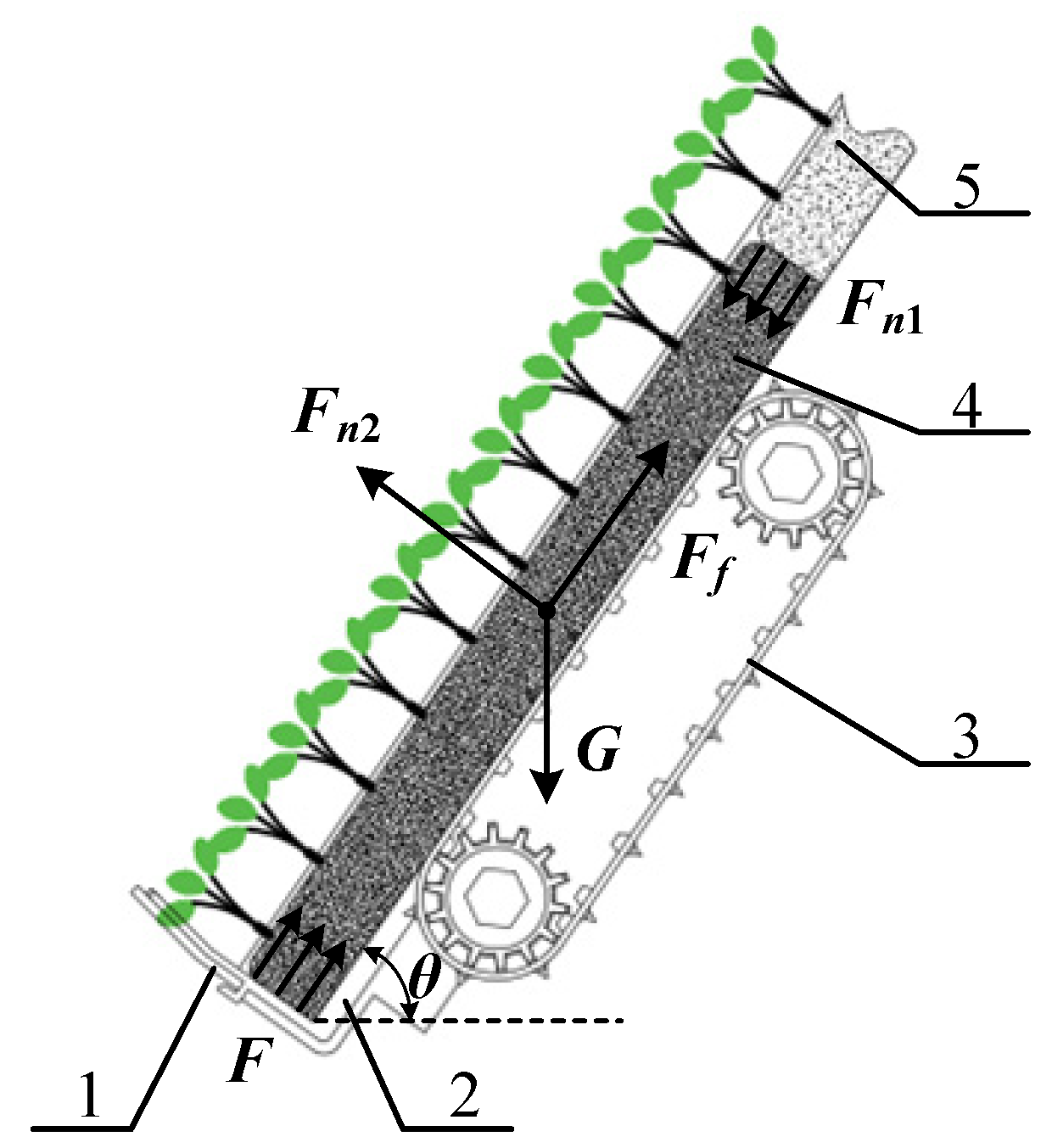


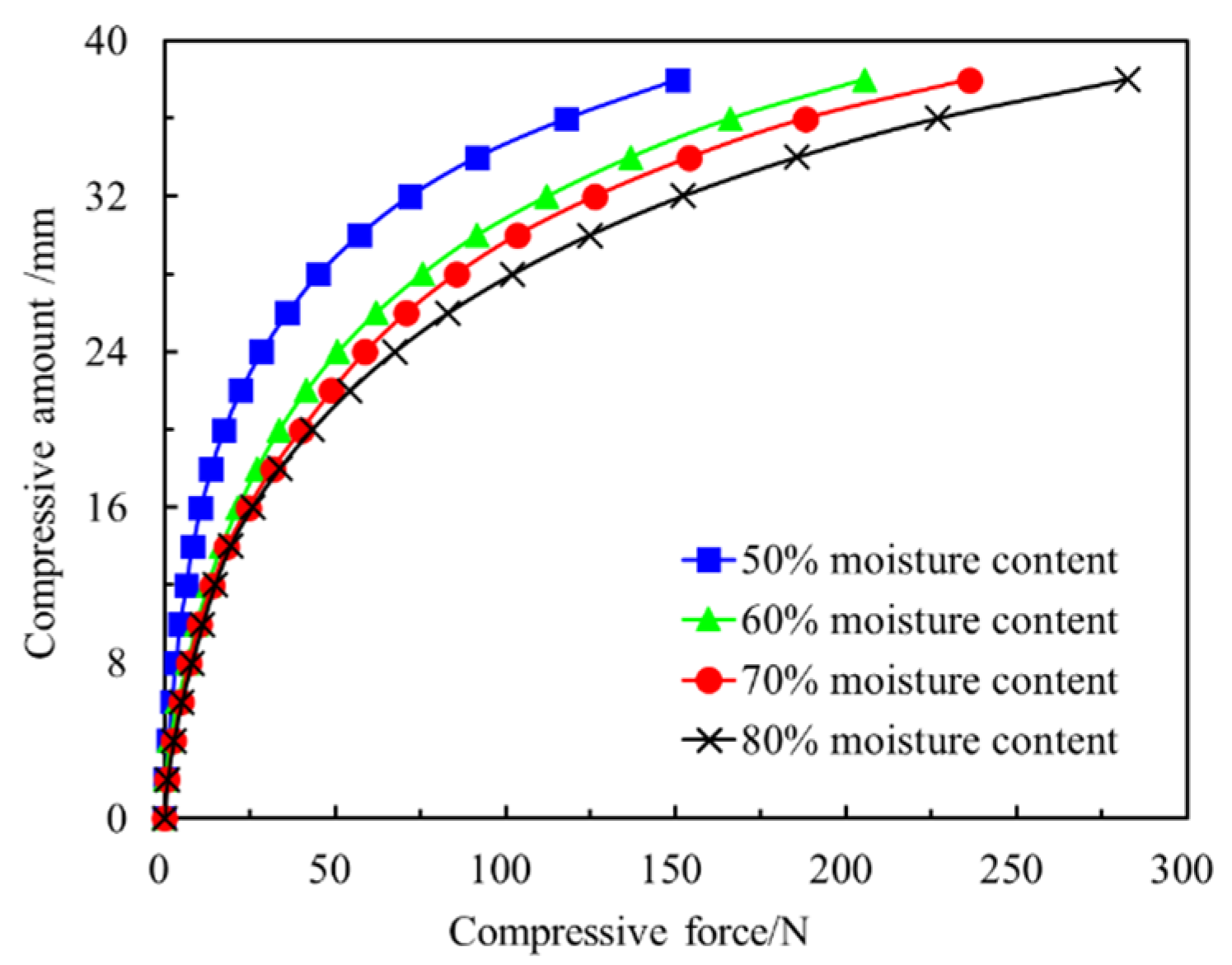
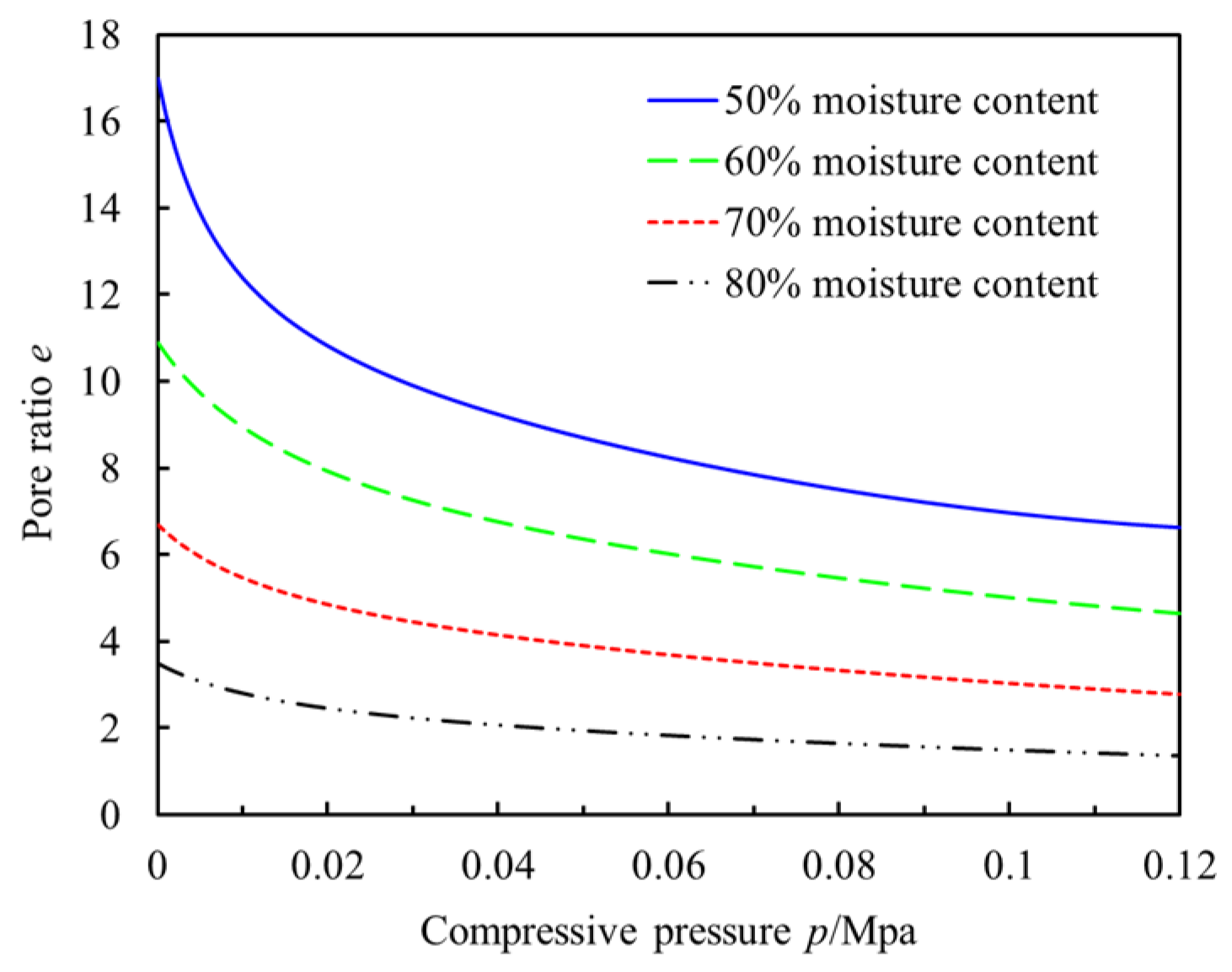

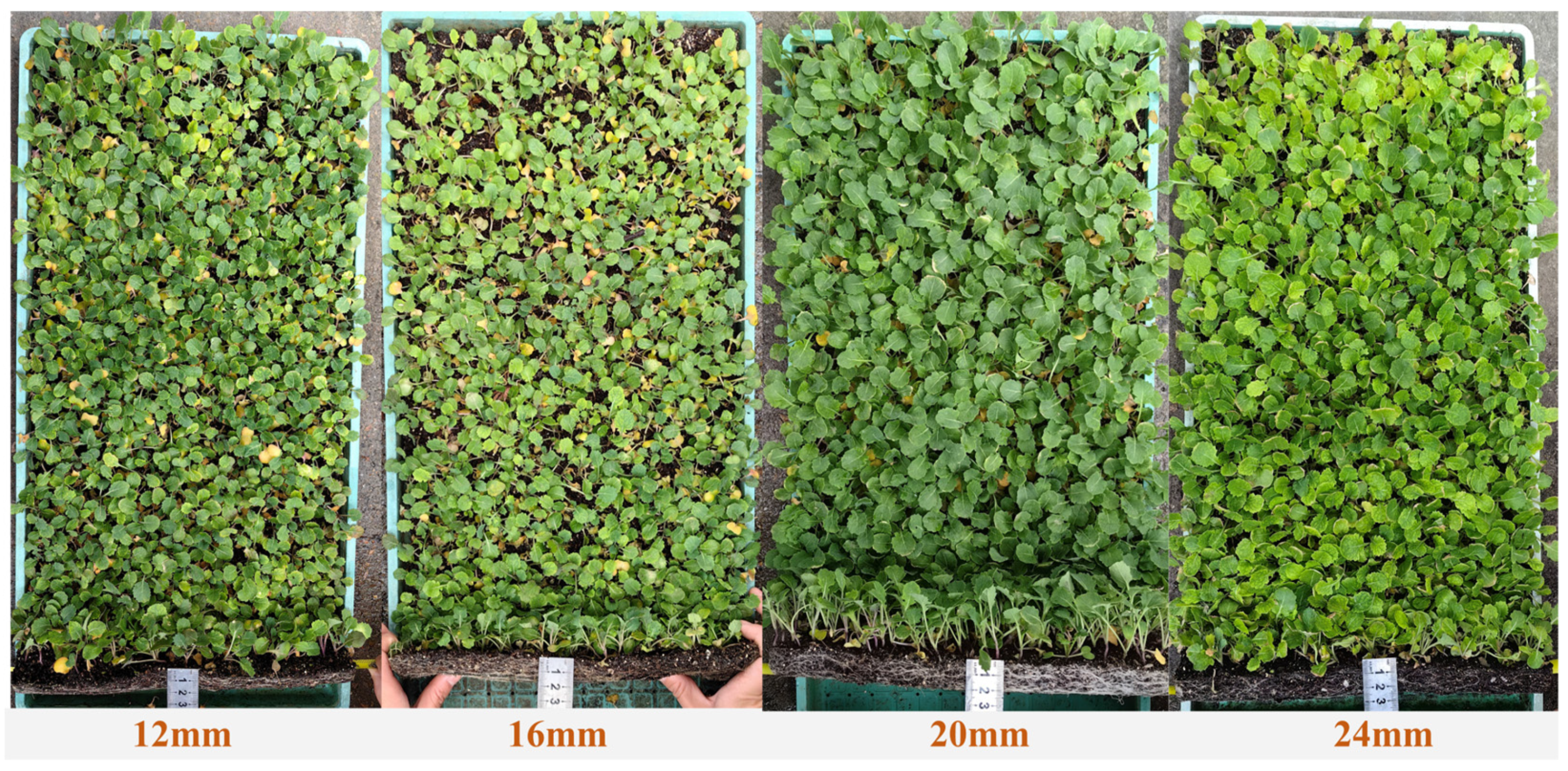
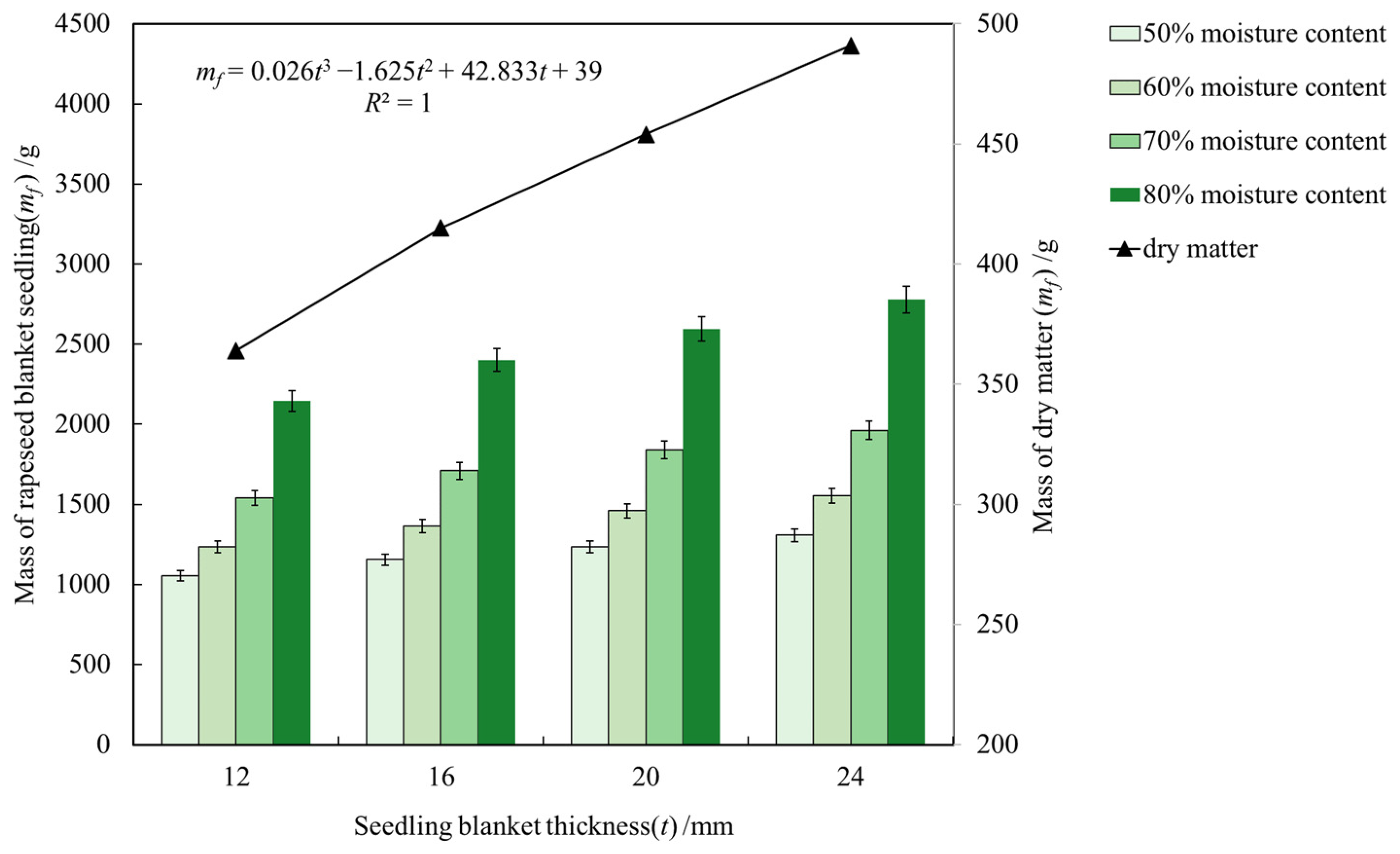

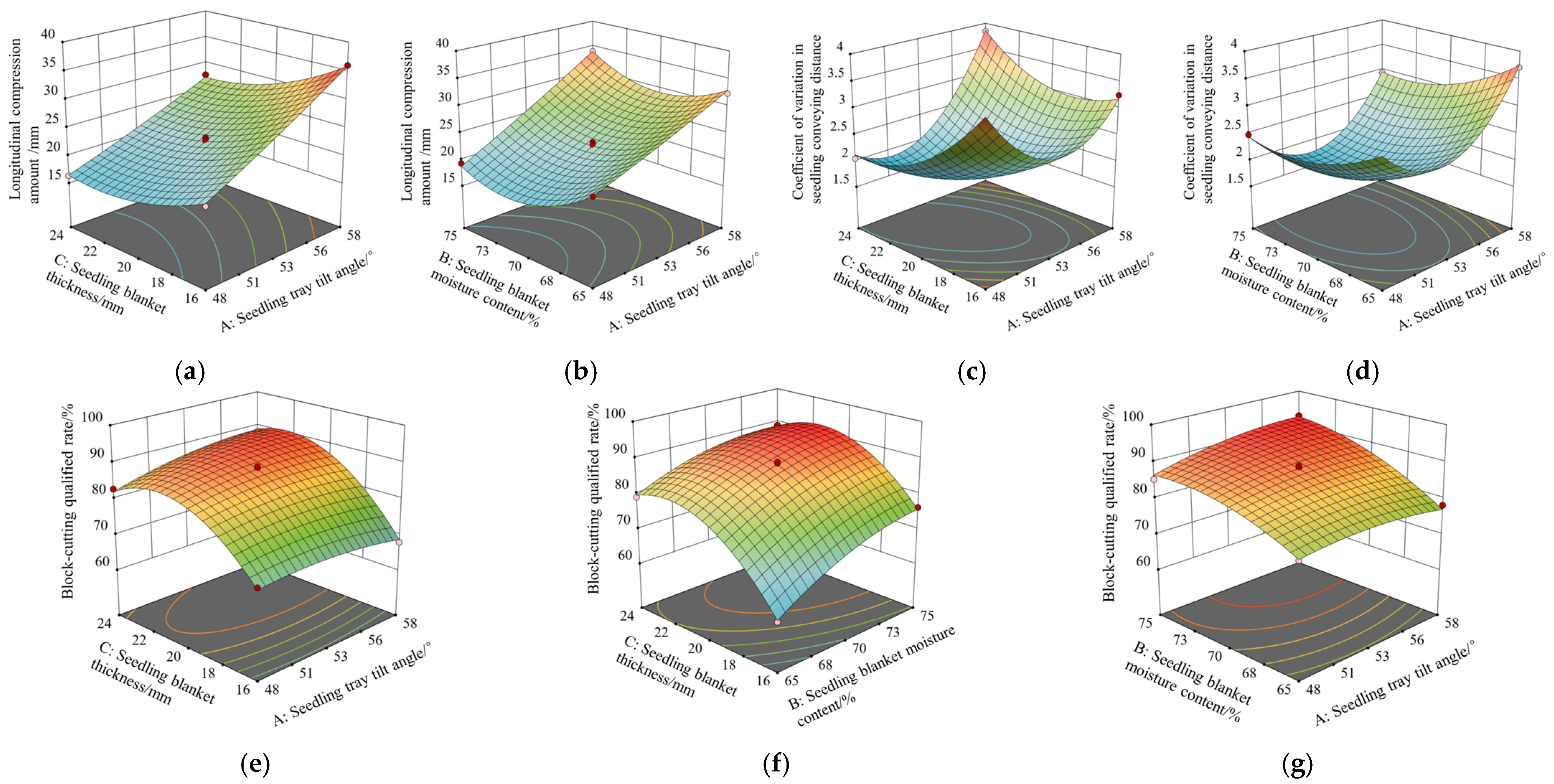
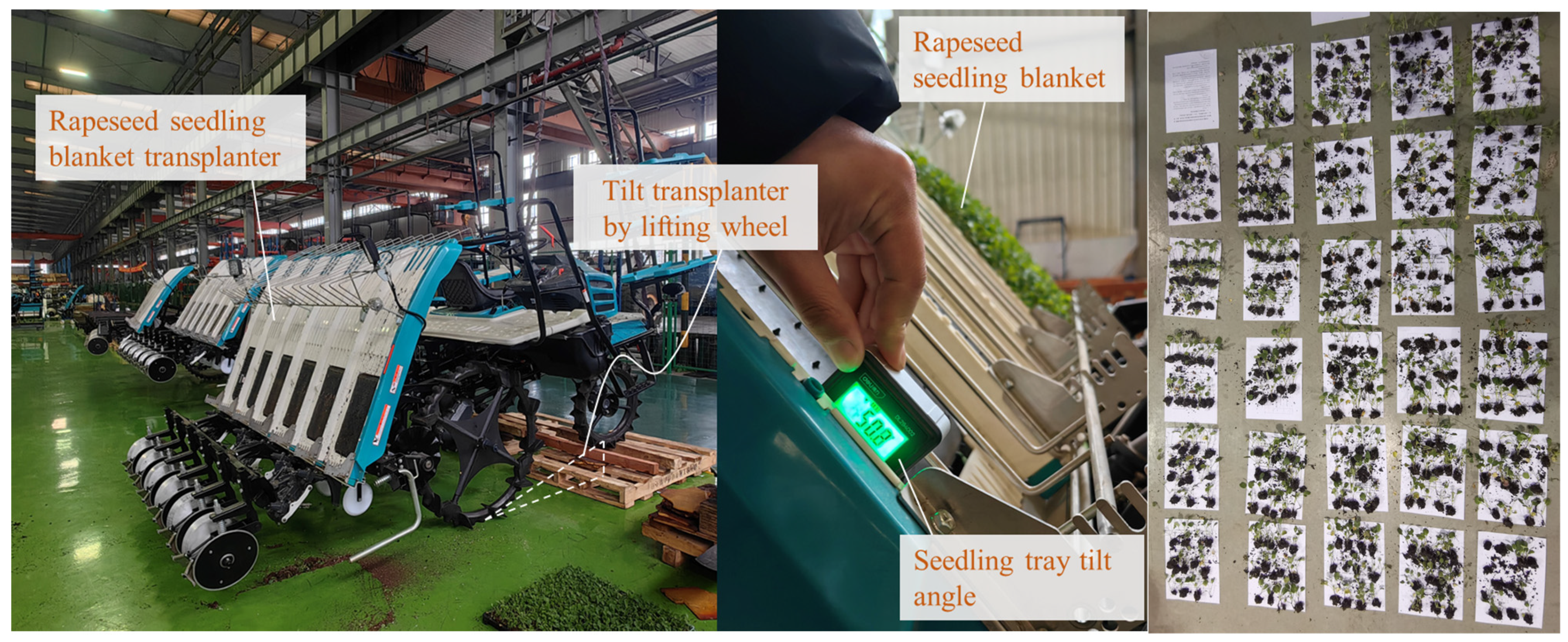
| Levels | Seedling Tray Tilt Angle, ° | Seedling Blanket Moisture Content, % | Seedling Blanket Thickness, mm |
|---|---|---|---|
| 1 | 38 | 50 | 12 |
| 2 | 48 | 60 | 16 |
| 3 (counter level) | 58 | 70 | 20 |
| 4 | 68 | 80 | 24 |
| Factor Level | Seedling Tray Tilt Angle, A (°) | Seedling Blanket Moisture Content, B (%) | Seedling Blanket Thickness, C (mm) |
|---|---|---|---|
| −1 | 48 | 65 | 16 |
| 0 | 53 | 70 | 20 |
| 1 | 58 | 75 | 24 |
| Number | A/(°) | B/(%) | C/(mm) | Y1/mm | Y2 | Y3/% | Comprehensive Scores Dv |
|---|---|---|---|---|---|---|---|
| 1 | −1 | −1 | 0 | 22.67 | 2.99 | 77.8 | 53.79 |
| 2 | −1 | 0 | −1 | 20.67 | 3.65 | 71.1 | 41.14 |
| 3 | −1 | 0 | 1 | 16.33 | 2.05 | 82.8 | 87.84 |
| 4 | −1 | 1 | 0 | 19.33 | 2.48 | 85.3 | 74.84 |
| 5 | 0 | −1 | −1 | 33 | 3.04 | 60.3 | 21.63 |
| 6 | 0 | −1 | 1 | 27 | 2.8 | 80.1 | 50.01 |
| 7 | 0 | 0 | 0 | 22 | 1.79 | 88.1 | 84.44 |
| 8 | 0 | 0 | 0 | 23.33 | 1.79 | 88.6 | 82.02 |
| 9 | 0 | 0 | 0 | 22 | 1.83 | 89 | 84.18 |
| 10 | 0 | 0 | 0 | 23 | 1.89 | 88.1 | 80.46 |
| 11 | 0 | 0 | 0 | 22.67 | 1.78 | 87.4 | 82.86 |
| 12 | 0 | 1 | −1 | 32 | 2.45 | 76.2 | 44.37 |
| 13 | 0 | 1 | 1 | 24 | 2.05 | 89.9 | 76.37 |
| 14 | 1 | −1 | 0 | 32.33 | 3.71 | 78.2 | 20.39 |
| 15 | 1 | 0 | −1 | 36 | 3.25 | 67.9 | 15.87 |
| 16 | 1 | 0 | 1 | 27.67 | 3.84 | 90.2 | 34.32 |
| 17 | 1 | 1 | 0 | 34 | 2.94 | 94.7 | 41.54 |
| Source | Y1 | Y2 | ||||||
|---|---|---|---|---|---|---|---|---|
| Sum of Squares | df | F | p-Value | Sum of Squares | df | F | p-Value | |
| Model | 529.63 | 9 | 137.22 | <0.0001 | 3.77 | 9 | 210.26 | <0.0001 |
| A | 325.13 | 1 | 758.13 | <0.0001 ** | 0.37 | 1 | 184.08 | <0.0001 ** |
| B | 4.02 | 1 | 9.37 | 0.0183 * | 0.38 | 1 | 191.32 | <0.0001 ** |
| C | 88.91 | 1 | 207.32 | <0.0001 ** | 0.15 | 1 | 75.88 | <0.0001 ** |
| AB | 6.28 | 1 | 14.63 | 0.0065 * | 0.01 | 1 | 3.77 | 0.0934 |
| AC | 3.98 | 1 | 9.28 | 0.0187 * | 0.53 | 1 | 267.34 | <0.0001 ** |
| BC | 1 | 1 | 2.33 | 0.1706 | 0.00 | 1 | 1.43 | 0.2712 |
| A2 | 0.4447 | 1 | 1.04 | 0.3424 | 1.56 | 1 | 782.98 | <0.0001 ** |
| B2 | 72.78 | 1 | 169.7 | <0.0001 ** | 0.17 | 1 | 84.92 | <0.0001 ** |
| C2 | 21.17 | 1 | 49.37 | 0.0002 ** | 0.41 | 1 | 205.84 | <0.0001 ** |
| Residual | 3 | 7 | 0.01 | 7 | ||||
| Lack of fit | 1.58 | 3 | 1.49 | 0.3451 | 0.01 | 3 | 3.7 | 0.1194 |
| Pure Error | 1.42 | 4 | 0.00 | 4 | ||||
| Cor Total | 532.63 | 16 | 3.79 | 16 | ||||
| Source | Y3 | Dv | ||||||
| Sum of Squares | df | F | p-Value | Sum of Squares | df | F | p-Value | |
| Model | 1262.65 | 9 | 138.04 | <0.0001 | 10,446.69 | 9 | 215.37 | <0.0001 |
| A | 12.5 | 1 | 12.3 | 0.0099 * | 2645.36 | 1 | 490.82 | <0.0001 ** |
| B | 284.41 | 1 | 279.83 | <0.0001 ** | 1041.95 | 1 | 193.32 | <0.0001 ** |
| C | 504.03 | 1 | 495.92 | <0.0001 ** | 1969.34 | 1 | 365.39 | <0.0001 ** |
| AB | 12.25 | 1 | 12.05 | 0.0104 * | 0.0022 | 1 | 0.0004 | 0.9846 |
| AC | 18.49 | 1 | 18.19 | 0.0037 * | 199.48 | 1 | 37.01 | 0.0005 ** |
| BC | 9.3 | 1 | 9.15 | 0.0192 * | 3.29 | 1 | 0.6103 | 0.4603 |
| A2 | 11.92 | 1 | 11.73 | 0.0111 * | 1556.5 | 1 | 288.79 | <0.0001 ** |
| B2 | 39.36 | 1 | 38.73 | 0.0004 ** | 1068.02 | 1 | 198.16 | <0.0001 ** |
| C2 | 345.42 | 1 | 339.87 | <0.0001 ** | 1483.92 | 1 | 275.33 | <0.0001 ** |
| Residual | 7.11 | 7 | 37.73 | 7 | ||||
| Lack of fit | 5.66 | 3 | 5.2 | 0.0726 | 27.06 | 3 | 3.38 | 0.135 |
| Pure Error | 1.45 | 4 | 10.67 | 4 | ||||
| Cor Total | 1269.76 | 16 | 10,484.41 | 16 | ||||
| Test Result | Longitudinal Block-Cutting Width | Number of Rows in Block Cutting | Number of Cut Blocks Per Plate | Empty Seedling Rate, % | Qualified Seedling Picking Rate, % |
|---|---|---|---|---|---|
| 1 | 17 mm | 33 | 396 | 4.0 | 93.4% |
| 2 | 18 mm | 31 | 372 | 8.3 | 87.0% |
Disclaimer/Publisher’s Note: The statements, opinions and data contained in all publications are solely those of the individual author(s) and contributor(s) and not of MDPI and/or the editor(s). MDPI and/or the editor(s) disclaim responsibility for any injury to people or property resulting from any ideas, methods, instructions or products referred to in the content. |
© 2024 by the authors. Licensee MDPI, Basel, Switzerland. This article is an open access article distributed under the terms and conditions of the Creative Commons Attribution (CC BY) license (https://creativecommons.org/licenses/by/4.0/).
Share and Cite
Jiang, L.; Zhu, T.; Tang, Q.; Wu, J.; Jiang, D.; Huang, M. Mechanical Characteristics Testing and Parameter Optimization of Rapeseed Blanket Seedling Conveying for Transplanters. Agriculture 2024, 14, 699. https://doi.org/10.3390/agriculture14050699
Jiang L, Zhu T, Tang Q, Wu J, Jiang D, Huang M. Mechanical Characteristics Testing and Parameter Optimization of Rapeseed Blanket Seedling Conveying for Transplanters. Agriculture. 2024; 14(5):699. https://doi.org/10.3390/agriculture14050699
Chicago/Turabian StyleJiang, Lan, Tingwei Zhu, Qing Tang, Jun Wu, Dong Jiang, and Minghui Huang. 2024. "Mechanical Characteristics Testing and Parameter Optimization of Rapeseed Blanket Seedling Conveying for Transplanters" Agriculture 14, no. 5: 699. https://doi.org/10.3390/agriculture14050699





